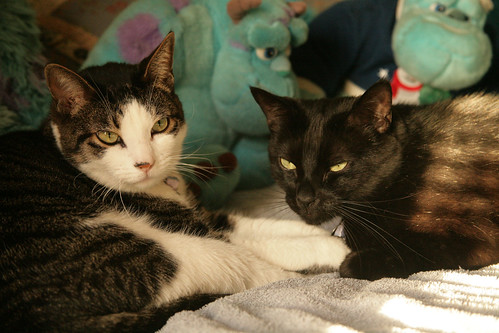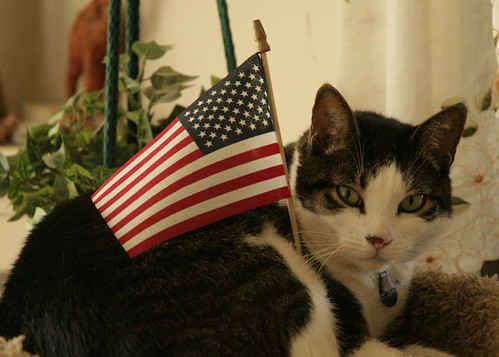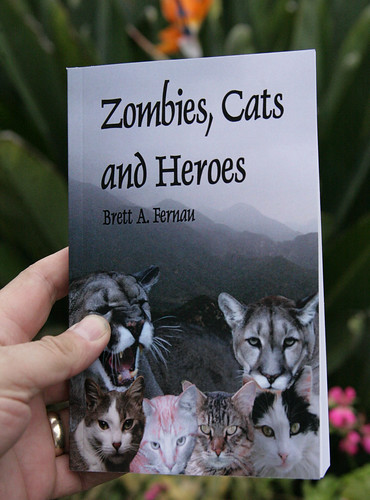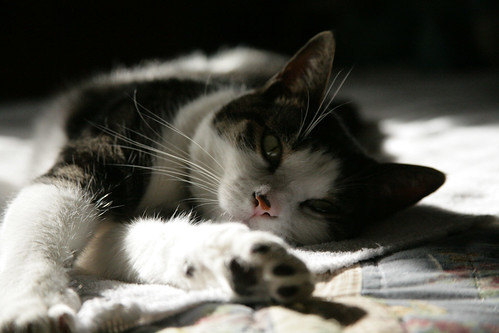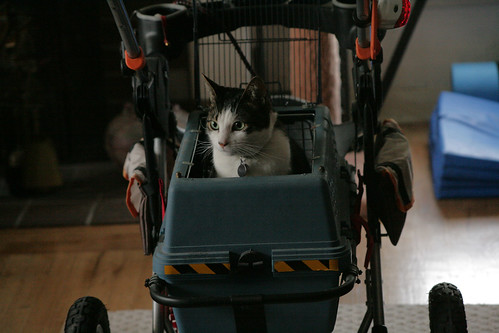 When we gave our cat the name “Quint”, or rather when he named himself, we had seen only a brief glimmering of what he would become. Even then, though, we knew that he was something, or someone, special. He had that spark that not every cat contains, that extra bit of life, that extra measure of awareness, of curiosity. He is what I call Cat-Plus.
There are cats that are just cats. They are adorable and they do all the things that a cat should do – chase a string, bat their toys around, climb into boxes and bags, dash about the house in a frenzy of imaginary hunting, purr, demand attention, leave the occasional wet hairball on the floor right where I’ll step on it with my bare feet, and all the other common cat activities. And then there are those cats that are a bit more than cats, the ones that have something to say to you and manage to find a way to communicate it to you despite the nearly insurmountable language barrier. It’s that undefinable extra bit that distinguishes the normal, everyday house cat from Cat-Plus.
I have one of each. Hedge, the black cat, has potential, but something horrible happened to him before he came to us that scared and scarred his little cat mind so thoroughly that he may never be completely free of it. I try to help him, but whatever happened to him is never very far from his thoughts and just about the time I think he might start to act like a normal, playful cat, the horror takes him and he has to go to one his “safe” places to get it under control. Whatever he sees when the horror takes him, makes him very afraid. He is the most submissive cat I have ever known. And he desperately wants everyone to like him, but he’s afraid of everyone but Quint, Carol and I, so his circle of friends is very small.
Quint is Cat-Plus. He smart and sensible and insatiably curious. He knows what he wants and he has learned how to tell us what that is. He has to know what is going on in the house at all times. He wants to know what we’re having for dinner, who we’re speaking to on the phone, where we’ve been walking, what’s in any bag or box that enters the house, what movie we’re watching, even what we’re reading. He doesn’t want to participate in any of our human activities, he just wants to know what we are doing. When there is something that he wants us to do with him, he comes to us and reaches out with a paw and taps us on the arm to get our attention and then tells us what he wants. I’m not a fluent in Cat as I would like to be so I don’t always know what Quint is saying to me, but most often it has something to do with grooming, feeding or playing. He likes having his fur brushed and, when I am sitting in my chair at the dining room table, he will insist that I brush him before I do anything else. I try telling him that I am eating and that he should wait until I’ve finished. He doesn’t listen. He keeps poking me on the arm with his claws until I pick him up and brush him. If he wants a ride in his stroller, he will jump in and sit there staring at us until we take him for a ride. Very often, he’ll just walk up to me and meow. I know he wants something, but it’s hard to tell just what that might be. I’m sure he thinks I’m too stupid to understand what he’s saying. He’s probably correct in that. I’ve never been very good at foreign languages, or even accents. I just don’t have an “ear” for them, I guess. I find myself saying, “Could you spell that, please?” what I’m talking to someone with a heavy accent. Poor Quint can’t spell and that makes understanding him all the more difficult.
I can understand some Cat words, like “Hi, I’m here!!” and “It’s dinnertime,” plus “I like that,” and “Leave me along, I’m busy.” Each cat has his/her own dialect which makes understanding them even more difficult. Hedge has a sound that means “Follow me” which is different from the one Quint makes to express that same concept. Since the cats can’t even agree among themselves what the sounds mean, I don’t feel badly about not always understanding them.
Quint has his own language and his own ways of making us understand what he needs and that is part of what makes him extraordinary. But he also has a presence that is immediately evident to anyone who meets him. There is something extra about him that isn’t easily describable. I think of it as a confident awareness of not only himself as a cat, but an awareness of himself in relation to his environment and the other inhabitants of that environment. He is himself and he knows it and he knows what that means.
Quint lives up to his name, which comes from quintessential. The word “quint” means five. “Quintessential” means, essentially, the fifth element. If the four elements are earth, air, fire and water, then the fifth element is the spirit. Quint is the spirit of Cat, the best of his kind. Okay, maybe you think your cat is better, smarter, more clever. You may be right. But Quint has that something extra that sets him apart from every other cat I have ever known. I consider him the quintessential cat. If you ever meet him, I believe you will agree.
When we gave our cat the name “Quint”, or rather when he named himself, we had seen only a brief glimmering of what he would become. Even then, though, we knew that he was something, or someone, special. He had that spark that not every cat contains, that extra bit of life, that extra measure of awareness, of curiosity. He is what I call Cat-Plus.
There are cats that are just cats. They are adorable and they do all the things that a cat should do – chase a string, bat their toys around, climb into boxes and bags, dash about the house in a frenzy of imaginary hunting, purr, demand attention, leave the occasional wet hairball on the floor right where I’ll step on it with my bare feet, and all the other common cat activities. And then there are those cats that are a bit more than cats, the ones that have something to say to you and manage to find a way to communicate it to you despite the nearly insurmountable language barrier. It’s that undefinable extra bit that distinguishes the normal, everyday house cat from Cat-Plus.
I have one of each. Hedge, the black cat, has potential, but something horrible happened to him before he came to us that scared and scarred his little cat mind so thoroughly that he may never be completely free of it. I try to help him, but whatever happened to him is never very far from his thoughts and just about the time I think he might start to act like a normal, playful cat, the horror takes him and he has to go to one his “safe” places to get it under control. Whatever he sees when the horror takes him, makes him very afraid. He is the most submissive cat I have ever known. And he desperately wants everyone to like him, but he’s afraid of everyone but Quint, Carol and I, so his circle of friends is very small.
Quint is Cat-Plus. He smart and sensible and insatiably curious. He knows what he wants and he has learned how to tell us what that is. He has to know what is going on in the house at all times. He wants to know what we’re having for dinner, who we’re speaking to on the phone, where we’ve been walking, what’s in any bag or box that enters the house, what movie we’re watching, even what we’re reading. He doesn’t want to participate in any of our human activities, he just wants to know what we are doing. When there is something that he wants us to do with him, he comes to us and reaches out with a paw and taps us on the arm to get our attention and then tells us what he wants. I’m not a fluent in Cat as I would like to be so I don’t always know what Quint is saying to me, but most often it has something to do with grooming, feeding or playing. He likes having his fur brushed and, when I am sitting in my chair at the dining room table, he will insist that I brush him before I do anything else. I try telling him that I am eating and that he should wait until I’ve finished. He doesn’t listen. He keeps poking me on the arm with his claws until I pick him up and brush him. If he wants a ride in his stroller, he will jump in and sit there staring at us until we take him for a ride. Very often, he’ll just walk up to me and meow. I know he wants something, but it’s hard to tell just what that might be. I’m sure he thinks I’m too stupid to understand what he’s saying. He’s probably correct in that. I’ve never been very good at foreign languages, or even accents. I just don’t have an “ear” for them, I guess. I find myself saying, “Could you spell that, please?” what I’m talking to someone with a heavy accent. Poor Quint can’t spell and that makes understanding him all the more difficult.
I can understand some Cat words, like “Hi, I’m here!!” and “It’s dinnertime,” plus “I like that,” and “Leave me along, I’m busy.” Each cat has his/her own dialect which makes understanding them even more difficult. Hedge has a sound that means “Follow me” which is different from the one Quint makes to express that same concept. Since the cats can’t even agree among themselves what the sounds mean, I don’t feel badly about not always understanding them.
Quint has his own language and his own ways of making us understand what he needs and that is part of what makes him extraordinary. But he also has a presence that is immediately evident to anyone who meets him. There is something extra about him that isn’t easily describable. I think of it as a confident awareness of not only himself as a cat, but an awareness of himself in relation to his environment and the other inhabitants of that environment. He is himself and he knows it and he knows what that means.
Quint lives up to his name, which comes from quintessential. The word “quint” means five. “Quintessential” means, essentially, the fifth element. If the four elements are earth, air, fire and water, then the fifth element is the spirit. Quint is the spirit of Cat, the best of his kind. Okay, maybe you think your cat is better, smarter, more clever. You may be right. But Quint has that something extra that sets him apart from every other cat I have ever known. I consider him the quintessential cat. If you ever meet him, I believe you will agree.
Happy Solstice! Clonehenge Says Good Bye :’-(
10 months ago
